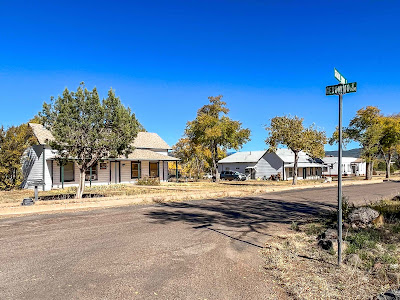Located on the White Mountain Apache Tribe’s land, Fort Apache was a U.S. Army fort in the 19th century and is now a National Historic Landmark. I spent a day there last November, learning about Apache history, about the fort and its work, and what happened after the Army left. The site looks nothing like the fort in the 1948 movie called Fort Apache, which I wrote about in another post.
 |
| Banner in the Arrowhead Cafe |
Fort Apache is about five miles south of Whiteriver, just off Highway 73, in Navajo County, Arizona. After paying the entrance fee which, at the time of my visit, was $10.00, you’ll get a map of the site which you can use to orient yourself. However, I recommend buying the Fort Apache Walking Tour Guide because that contains a lot of background information.
 |
| Sign at entrance to Fort Apache Historic Park |
To the left of the entrance, in the same building, is the Nohwiké Bágowa Museum. Translated as House of Our Footprints, it provides an excellent introduction to Apache history and culture. You’ll definitely want to spend some time here to get an idea of how the Ndee people, the White Mountain Apache word for themselves, lived before, during, and after the Army occupied the place.
A well-stocked gift shop is also in the museum. I had read online that everything sent from the post office here was stamped with a Fort Apache postmark, which I thought would be fun to have as a souvenir. Another gift shop, with different items, is located in another building.
 |
| U.S. Post Office at Fort Apache |
Fort Apache was originally called Camp Ord and was founded in 1870. General George Crook enlisted the cooperation of local Apaches as scouts who helped the Army in their wars against other Indigenous people. One of the buildings on the site has an exhibit with detailed information about why the White Mountain Apache people aided Crook in the Apache Wars in the second half of the 19th century. There were economic, political, and other reasons but the exhibit also makes clear that the presence of the Army also completely changed the Apache people’s traditional way of life. One very interesting fact is that 12 Apache scouts received the Congressional Medal of Honor in 1872.
 |
| View of one area of Fort Apache |
In 1922, the Army vacated Fort Apache. The next year, an Indian boarding school was established on the fort’s grounds. Named the Theodore Roosevelt School, today it’s a middle school for local children.
 |
| Another view of Fort Apache |
Although Fort Apache isn’t large and following the walking tour won’t take long, if you stop to read all the information plaques, enter the buildings that are open to the public, eat in the Arrowhead café, browse the gift shops, take photos, and just soak up the atmosphere, you can easily spend several hours there, as I did. Anyone who is interested in the Old West, Arizona history, Indigenous culture and history, and Army life will enjoy visiting Fort Apache Historic Park.




